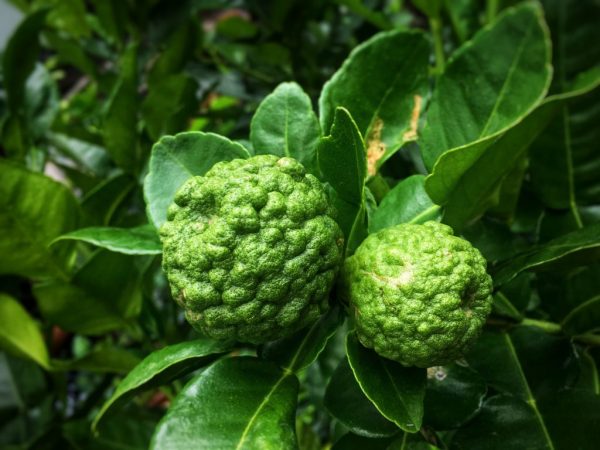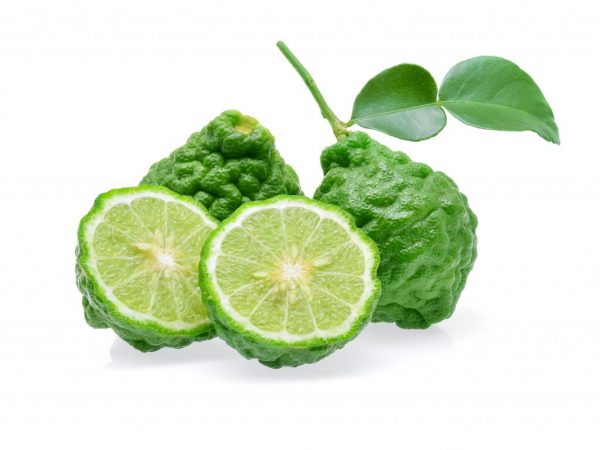Kaffir lime and its uses
Kaffir lime is a fruit tree from the rue family of the citrus genus. It is appreciated in cooking and medicine for its special taste and health benefits.

Kaffir lime and its uses
Botanical characteristic
Kaffir lime belongs to the subgenus of citrus papeda. It is an evergreen fruit tree, reaching a height of 2-6 m in natural conditions. When grown at home, the plant usually reaches a height of 1-2 m. There are many thorns on the multi-stemmed branches. Inflorescences are white.
Despite the name, Kaffir lime is not a classic lime fruit.
The leaves of the kaffir lime are dark green in color, with a glossy shiny surface on top and a pale pore on the bottom. Their upper part is pointed, and the lower is more rounded. In appearance, the leaves resemble the number "8". The foliage is 2-10 cm long. It has a specific lime, tangerine and lemon aromas with a floral tinge.
The plant has several names: kaffir lime, papeda black-leaved, makroot, kafir lime, lima.
The fruit is small, round, inedible. Due to the bumpy surface of the peel, the dark green color resembles wrinkled dried lime in appearance. As it ripens, the peel acquires a lighter color with a yellowish tinge. The amount of juice in the fruit is minimal. By taste, the fruit is sour, bitterness is inherent in it.
Useful properties and limitations
The chemical composition of the peel and leaves of kaffir lime contains organic compounds that have a beneficial effect on health:
- limonene, which provides a specific smell, helps to normalize the digestive system, has an antispasmodic and mild choleretic effect,
- terpene aldehyde citronel, which gives foliage a special taste and has antimicrobial properties,
- antioxidants that remove free radicals.
Kaffir lime is used to:
- preserving dental health by suppressing pathogens that are sources of inflammatory processes,
- prevention of cancer due to high antioxidant effects,
- relieving inflammation, pain and swelling,
- normalization of blood pressure,
- general strengthening of the body and enhancing immunity due to the high content of ascorbic acid.
Kaffir lime is often used in aromatherapy to stabilize the psychological state, normalize sleep, relieve depression and anxiety, and chronic stress. It is contraindicated in pregnancy and a tendency to allergic reactions to citrus fruits.
Growth geography and scope

The fruits have found their application in cosmetology
Originally from India, today Kaffir lime is widespread in Southeast Asia, including it is cultivated in Laos, Sri Lanka, Africa, Thailand, western Malaysia, Central America, Indonesia, and the Philippines.
Scope of application
Kaffir lime is mainly used in the cosmetic and culinary fields.In Thailand, the fruits are sometimes used for the production of household chemicals.
Cosmetology
The peel of lime fruits is used mainly in the manufacture of essential oils for cosmetic massage. The dried and crushed foliage of the plant as a scrubbing component is included in cosmetic peels for the face and body, and is also included in anti-dandruff and hair loss shampoos and in nail care products. Acts as a brightening agent for excessive pigmentation.
Cooking
The main value of a plant lies in its foliage. With its complex citrus-herbal aroma, it is a key seasoning in the cooking of Thailand and other South Asian countries. It is used fresh, frozen and dried.
The foliage of kaffir lime is one of the main ingredients in the preparation of a traditional Thai dish - spicy and sour tom yam soup.
The aromatic lime foliage brings uniqueness to first courses, salads, curries, stews, rice, fish, seafood and other Asian food for a fresh, full-bodied flavor. It is used as a seasoning for pickling vegetables; for a spicy taste, it is added to marinades for chicken and meat. Tea is brewed with kaffir lime leaves, and they are used to make tonic drinks. Sometimes the peel is used to make desserts.
Conclusion
Kaffir lime belongs to the citrus genus. It grows in a number of countries in the southeastern part of Asia, has a healthy chemical composition and a specific aroma and taste, thanks to which it is widely used in folk medicine, Asian cuisine and cosmetology.


